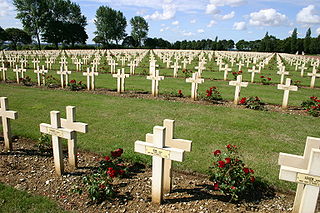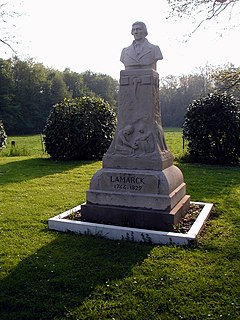
Arras is the capital (chef-lieu/préfecture) of the Pas-de-Calais department, which forms part of the region of Hauts-de-France; prior to the reorganization of 2014 it was located in Nord-Pas-de-Calais. The historic centre of the Artois region, with a Baroque town square, Arras is located in Northern France at the confluence of the Scarpe river and the Crinchon River.

Givenchy-en-Gohelle is a commune in the Pas-de-Calais department in the Hauts-de-France region of France. It is located 1.8 kilometres (1.1 mi) north of the Canadian National Vimy Memorial dedicated to the Battle of Vimy Ridge and the missing First World War Canadian soldiers with no known grave; the Memorial is also the site of two Canadian cemeteries. The village was destroyed during World War I but was rebuilt after the war.

Bloody April refers to April 1917, and is the name given to the British air support operations during the Battle of Arras, during which particularly heavy casualties were suffered by the Royal Flying Corps at the hands of the German Luftstreitkräfte.

The Battle of Arras was a British offensive on the Western Front during World War I. From 9 April to 16 May 1917, British troops attacked German defences near the French city of Arras on the Western Front. The British achieved the longest advance since trench warfare had begun, surpassing the record set by the French Sixth Army on 1 July 1916. The British advance slowed in the next few days and the German defence recovered. The battle became a costly stalemate for both sides and by the end of the battle, the British Third and First Armies had suffered about 160,000 and the German 6th Army about 125,000 casualties.
The name Battle of Arras refers to a number of battles which took place near the town of Arras in Artois, France:

The Hundred Days Offensive was an Allied offensive which ended the First World War. Beginning with the Battle of Amiens on the Western Front, the Allies pushed Central Powers back after their gains from the Spring Offensive. The Germans eventually retreated to the Hindenburg Line, culminating in the Armistice of 11 November 1918. The term "Hundred Days Offensive" does not refer to a battle or strategy, but rather the rapid series of Allied victories against which the German armies had no reply.

The Dury Memorial is a World War I Canadian war memorial that commemorates the actions of the Canadian Corps in the Second Battle of Arras, particularly their breakthrough at the Drocourt–Quéant Line switch of the Hindenburg Line just south of the town of Dury. The Drocourt–Quéant Line was a main position in the German Army's defensive position in the area. The action took place on 2 and 3 September 1918 during a period known as the Hundred Days Offensive or Canada's Hundred Days. Particularly noteworthy for such a brief battle was that seven Canadians earned a Victoria Cross on 2 September during the battle.

Notre Dame de Lorette, also known as Ablain St.-Nazaire French Military Cemetery, is the world's largest French military cemetery. It is the name of a ridge, basilica, and French national cemetery northwest of Arras at the village of Ablain-Saint-Nazaire. The high point of the hump-backed ridge stands 165 metres high and – with Vimy Ridge – utterly dominates the otherwise flat Douai plain and the town of Arras.

Ervillers is a commune in the Pas-de-Calais department in the Hauts-de-France region of France.

Feuchy is a commune in the Pas-de-Calais department in the Hauts-de-France region of France. It is a small village, with a little more than 1000 inhabitants, and had only about 500 inhabitants in 1914. It is situated two kilometers east of Arras. During World War I, in 1914, it was occupied by German troops. British troops took over the Arras sector in March 1916. On April 9, 1917, the British operation "big push" led to advancement of several miles to the east in a battle with one with the most casualties per day, and Feuchy was liberated. The German offensives placed Feuchy under their control in 1918 until the Canadians cleared the area in August 1918. The population of Feuchy was evacuated and the village was completely destroyed.
The 111th Infantry Division was a formation of the Imperial German Army in World War I. The division was formed on March 25, 1915, near Brussels, Belgium and organized over the next several weeks. It was part of a wave of new infantry divisions formed in the spring of 1915. The division was disbanded in 1919 during the demobilization of the German Army after World War I.

Quéant is a commune in the Pas-de-Calais department in the Hauts-de-France region of France.

Bazentin is a commune in the Somme department in Hauts-de-France in northern France.

Irles is a commune in the Somme department in Hauts-de-France in northern France.

The Otago Mounted Rifle Regiment was a New Zealand Mounted Regiment formed for service during the Great War. It was formed from units of the Territorial Force consisting of the 5th Mounted Rifles, the 7th (Southland) Mounted Rifles and the 12th (Otago) Mounted Rifles. They saw service during the Battle of Gallipoli, with the New Zealand Mounted Rifles Brigade and was later withdrawn to Egypt. They later left the brigade and served in France with the New Zealand Division becoming the only New Zealand Mounted troops to serve in France.
Battle of Albert was the third battle by that name fought during World War I, following the First Battle of Albert and the Second Battle of Albert, with each of the series of three being fought roughly two years apart. This smaller third battle was significant in that it was the opening push that would lead to the Second Battle of the Somme and involved the Australian Corps. This attack opened the advance, with the main attack being launched by the Third Army along with support from the Fourth Army. The Second Battle of Bapaume, from 25 August to 3 September, was a continuation of this battle.

The Arras Memorial is a World War I memorial in France, located in the Faubourg d'Amiens British Cemetery, in the western part of the town of Arras. The memorial commemorates 34,785 soldiers of the forces of the United Kingdom, South Africa and New Zealand, with no known grave, who died in the Arras sector between the spring of 1916 and 7 August 1918.
The 62nd Division was an infantry division of the British Army that saw active service on the Western Front during the First World War.

The British XVII Corps was a British infantry corps during World War I.

The 25th Battalion, CEF was a unit in the Canadian Expeditionary Force during the Great War. It was the first of three to be raised entirely in Nova Scotia during the war. The 25th served in Belgium and France as part of the 5th Infantry Brigade, 2nd Canadian Division from 16 September 1915 until the end of the war. Regimental headquarters were established at the Halifax Armouries, with recruitment offices in Sydney, Amherst, New Glasgow, Truro and Yarmouth. Of the 1000 Nova Scotians that started with the battalion, after the first year of fighting, 100 were left in the battalion, while 900 men were killed, taken prisoner, missing or injured.


















